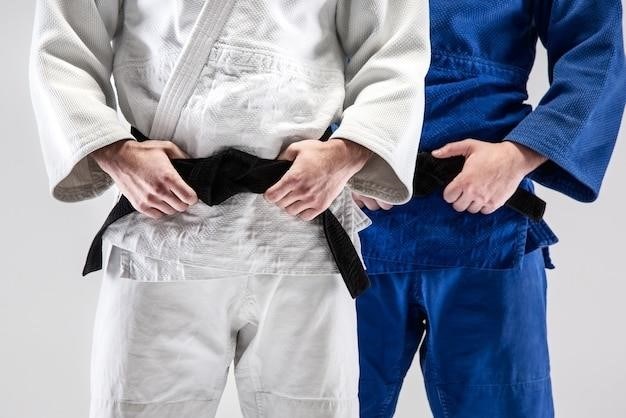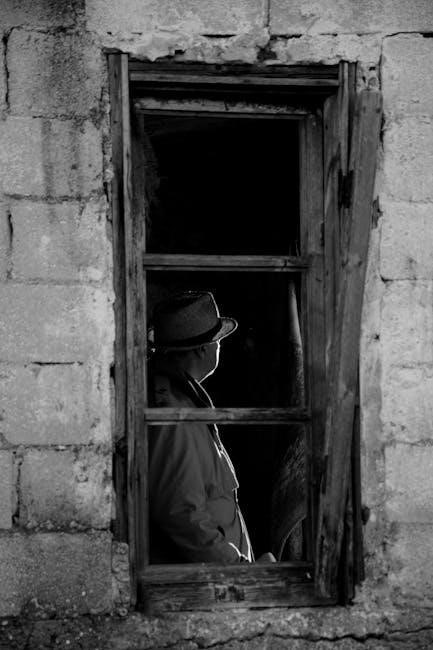BJJ Belt Size Guide⁚ Finding the Perfect Fit
A well-fitting BJJ belt is crucial for comfort and performance on the mats. This guide will help you navigate the world of BJJ belt sizing, ensuring you choose the perfect fit for your training journey.
Understanding BJJ Belt Sizing
BJJ belts are sized based on the practitioner’s waist size, not their height or weight. Unlike clothing sizes, which often incorporate a range of measurements, BJJ belts are typically designated with a specific length. This length is measured in centimeters or inches and is designed to wrap around the waist and tie securely with a double knot.
The most common sizing system for BJJ belts uses a letter-based system, with “A” indicating an adult size and numbers following to denote increasing length. For example, an A1 belt is shorter than an A2 belt, and an A4 belt is longer than an A3 belt. This system helps ensure that the belt fits snugly around the waist without being too short or too long.
It’s important to note that belt sizing can vary slightly between different brands. Some manufacturers may use a slightly different sizing system, so it’s always best to consult the specific size chart provided by the brand you are purchasing from.
Why Belt Size Matters
A BJJ belt that is the wrong size can negatively impact your training in several ways. If your belt is too short, it will be difficult to tie securely, and it may even come undone during training. This can be a safety hazard, as it could become entangled with your opponent’s gi, or it could simply be a nuisance, constantly needing to be re-tied.
On the other hand, a belt that is too long can also be problematic. It might be difficult to maneuver, especially when trying to execute certain techniques that require a lot of movement. It could also be uncomfortable and distracting, as the excess length of the belt might flap around and get in the way.
Ultimately, the right size belt will allow you to focus on your training without having to worry about your belt. It will be comfortable, secure, and will not hinder your movements. This is why it is important to take the time to measure your waist and select a belt that is the right size for you.
BJJ Belt Size Chart
BJJ belt size charts typically use a system of letter and number combinations to indicate the belt’s length. Common size designations include A0, A1, A2, A3, A4, A5, and A6, with each letter representing a specific length. A0 is generally the smallest size, and the size increases with each subsequent letter.
For example, an A0 belt is approximately 106 inches long, while an A1 belt is approximately 110 inches long. The exact length of each belt size can vary slightly depending on the manufacturer, so it’s important to consult the size chart provided by the specific brand you are considering.
In addition to the letter-number designations, some brands also offer belts in specific lengths, measured in centimeters or inches. This can be helpful if you need a belt that is slightly longer or shorter than the standard sizes.
Factors Affecting Belt Size
Several factors can influence the ideal BJJ belt size for you, ensuring a comfortable and secure fit. It’s not just about your waist measurement, but also about your individual preferences and training style.
Your build and height play a crucial role. Taller individuals might need a larger belt, while those with a broader waistline might require a longer belt to accommodate the double knot. The type of knot you prefer can also affect the necessary length. Some practitioners favor a shorter knot, while others prefer a longer one for a more secure fit.
The type of gi you wear can impact your belt size choice. Some gis have wider waistbands, requiring a slightly longer belt to fit comfortably. The thickness of the belt itself also matters, as a thicker belt might need a slightly larger size for a secure fit.
It’s advisable to consider the level of comfort you desire. Some practitioners prefer a snug fit, while others prefer a looser fit to allow for better airflow. Ultimately, the most important factor is finding a belt that feels comfortable and secure during your training sessions.

Choosing the Right Belt Size
Selecting the right BJJ belt size is essential for a comfortable and functional training experience. A belt that’s too short can be uncomfortable and restrict your movement, while one that’s too long can be distracting and even dangerous. Here’s a breakdown of the process⁚
The first step is to measure your waist accurately. Use a flexible measuring tape and wrap it around your waist at the natural waistline, ensuring it’s snug but not too tight. Record the measurement in centimeters or inches.
Once you have your waist measurement, consult the belt size chart provided by the manufacturer. Most BJJ belt size charts are based on waist measurements and offer a range of sizes from A0 to A6 or larger, depending on the brand.
If you fall between two sizes, it’s generally recommended to go with the larger size for a more comfortable fit; Remember that BJJ belts are designed to be worn with a double knot, which can significantly affect the overall length. It’s always better to have a slightly longer belt than a shorter one.
Measuring Your Waist
Accurately measuring your waist is the foundation for selecting the right BJJ belt size. A precise measurement ensures a comfortable and functional fit, allowing you to focus on your training without discomfort or distractions. Here’s a step-by-step guide⁚
Locate Your Natural Waistline⁚ Find the narrowest part of your torso, usually just above your hipbones. This is your natural waistline.
Use a Flexible Measuring Tape⁚ Grab a flexible measuring tape, ensuring it’s not stretched or damaged.
Wrap the Tape Around Your Waist⁚ Wrap the tape around your waist at your natural waistline, making sure it’s snug but not too tight. The tape should be level and parallel to the floor.
Record Your Measurement⁚ Note your waist measurement in centimeters or inches, depending on your preference. This measurement will be crucial when consulting BJJ belt size charts.
Double Check⁚ Repeat the process a few times to ensure accuracy, as even a slight difference in measurement can affect the belt’s fit.
Belt Size Chart for Popular Brands
Each BJJ brand has its own sizing system, so it’s essential to refer to the specific size chart provided by the manufacturer. Here are some popular BJJ brands and their corresponding belt size charts, offering a general idea of belt sizing across the industry⁚
• Tatami⁚ Tatami belts are known for their quality and durability. Their size chart often uses designations like A0, A1, A2, and so on, with each size corresponding to a specific waist measurement.
• Fuji⁚ Fuji belts are another popular choice among BJJ practitioners. Their size charts typically provide a clear correlation between waist measurements and belt sizes;
• Venum⁚ Venum belts are recognized for their stylish designs and comfortable fit. Their size charts usually offer a detailed breakdown of belt lengths based on waist measurements.
• Progress⁚ Progress belts are known for their affordability and decent quality. Their size charts often present belt lengths in centimeters or inches, making it easy to find the right fit.
• Sanabul⁚ Sanabul belts are popular for their value and comfort. Their size charts often feature a combination of waist measurements and belt lengths, providing a comprehensive guide.
Remember, these are just a few examples, and each brand may have its own unique sizing system. Always consult the specific size chart of the brand you’re interested in for accurate information.
Belt Sizing for Different Belt Types
While the general concept of BJJ belt sizing remains consistent, there are slight variations depending on the type of belt you choose. Here’s a breakdown of belt types and their sizing considerations⁚
• Standard BJJ Belts⁚ These are the most common type of belts used in BJJ training. They typically have a width of 1.75 inches and are available in various sizes based on waist measurements.
• Competition BJJ Belts⁚ These belts are designed for competition and may have stricter size requirements based on the rules of the specific organization. It’s crucial to check the competition regulations for belt sizing.
• Custom BJJ Belts⁚ Some practitioners prefer custom belts with unique designs or personal touches. In such cases, you’ll need to provide your exact waist measurement to the custom belt maker to ensure a perfect fit.
When choosing a belt, remember that a proper fit is crucial for comfortable and effective training. A belt that’s too tight can restrict movement and be uncomfortable, while a belt that’s too loose can easily come undone during training. Always refer to the specific size chart provided by the manufacturer for accurate sizing information.
Belt Size Chart for Kids
Finding the right BJJ belt size for kids is essential for their comfort and safety on the mats. Kids’ belts are typically shorter than adult belts and are designed to accommodate their smaller waist sizes. A properly sized belt allows for a secure fit without being too tight or too loose.
When choosing a BJJ belt for a child, it’s vital to refer to a dedicated kids’ size chart. These charts usually list belt sizes based on the child’s age or waist measurement. It’s also essential to consider the child’s growth rate. A belt that fits perfectly now might become too small as they grow, so choosing a size slightly larger than their current waist measurement can be a good idea.
Many BJJ brands offer a range of kids’ belt sizes, typically starting from smaller sizes like K0 or K1 and going up to K4 or K5. Some brands may also offer adjustable kids’ belts, which can be adjusted as the child grows. It’s crucial to check the specific sizing information provided by the manufacturer for accurate measurements and to ensure a comfortable and secure fit for your child.
Tips for Caring for Your BJJ Belt
A BJJ belt is an investment, and proper care can help extend its lifespan and keep it looking its best. Here are some essential tips to keep your belt in top condition⁚
Wash Regularly⁚ Wash your BJJ belt after each training session to remove sweat, bacteria, and grime. Use a gentle detergent and cold water, avoiding harsh chemicals or bleach.
Air Dry⁚ Avoid using a dryer as the heat can damage the belt material. Instead, hang your belt to air dry, away from direct sunlight, which can fade the color.
Avoid Harsh Treatment⁚ Be mindful of the belt’s fabric and avoid excessive pulling, twisting, or dragging it across rough surfaces. Treat it with care to prevent fraying or tearing.
Store Properly⁚ When not in use, store your belt in a cool, dry place, away from direct sunlight and moisture. This helps prevent mildew and keeps the belt in optimal condition.
By following these simple tips, you can ensure your BJJ belt remains in good condition for many training sessions to come.
Finding the right BJJ belt size is essential for both comfort and functionality on the mats. By understanding the factors that influence belt sizing, such as waist measurement, belt type, and brand variations, you can select a belt that fits perfectly and enhances your training experience.
Remember to consult size charts provided by manufacturers, measure your waist accurately, and consider the specific brand’s sizing guidelines. If you’re unsure, don’t hesitate to ask your instructor or a fellow BJJ practitioner for advice.
With the right belt size, you can focus on your technique and progress on your BJJ journey, free from distractions or discomfort. A well-fitting belt is a small detail that can make a big difference in your overall training experience.




Be the first to reply